Often when people hear the word “brand,” the first thing that springs to mind is a business name or logo. However, brand encompasses much more—and it’s a key part of your value as a business.
Follow along as I explain what a brand strategy is and how to create one, step by step. Then, use the provided brand strategy template to help form and implement an effective brand strategy for your business.
Free Brand Strategy Template
To focus and capture your brand ideas, follow the steps outlined in the free Brand Strategy Template and start building a powerful brand and your plan to take it to market. Plus, use our Brand Strategy Wheel for a simple and memorable way to envision your path to an effective brand strategy.
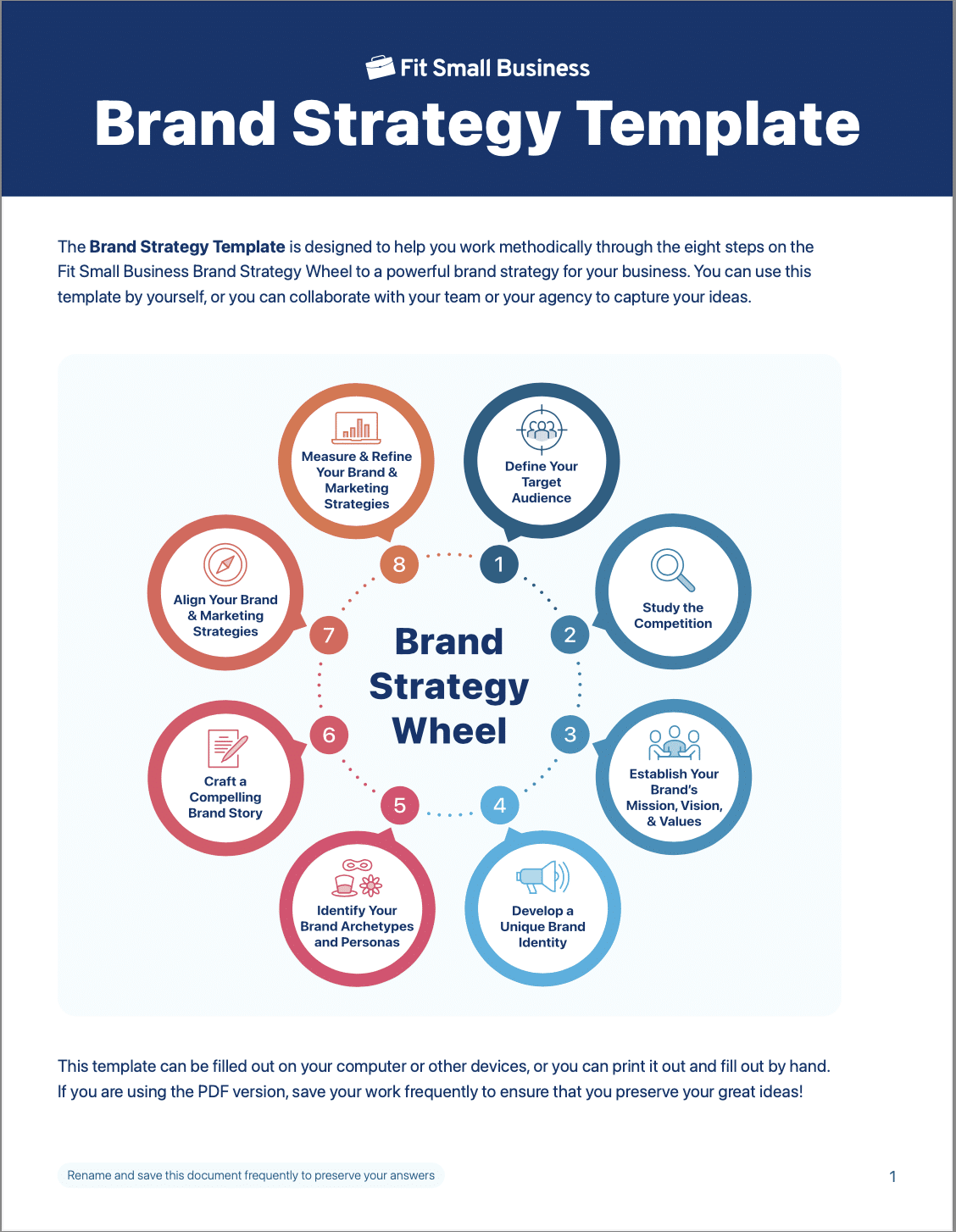
Thank you for downloading!
The Fit Small Business Brand Strategy Template. You can use this template to develop a comprehensive brand strategy for your business.
Quick Tip:
Need professional help developing your Brand Strategy?
Reach out to Straight North for expert branding help tailored to the small business owner.
For more informative articles from Fit Small Business, Please visit our website at https://fitsmallbusiness.com/marketing/.
Why Do I Need a Brand Strategy?
Small businesses often have a number of daily challenges and responsibilities just to keep the lights on and the doors open. It may seem to you if you are a small business owner or manager that brand strategy is too esoteric or expensive to invest time and energy.
Not so: small businesses need to stand out, be attractive to customers, and be memorable in the marketplace. Investing in your brand is a substantial investment in your business and builds brand value, the intrinsic value of the brand as part of your asset portfolio. Branding can account for as much as 30%-50% of your company’s value by communicating your unique value in the marketplace
How to Develop a Brand Strategy in 8 Steps
The process of building a brand strategy is both internal and external. First, you develop an idealized image of the customer through research, discovering the needs and desires of your target customers. This image is compared to the mission, vision, values, and story you create for your brand.
This internal process forms the core of your brand strategy, and then you convert these brand elements into external messaging that can be shared with customers, partners, and employees. The goal is to become the most memorable and trusted brand that customers will choose over competitors in your chosen market space.
A brand strategy has several important core elements you’ll need to develop, and each builds on the next:
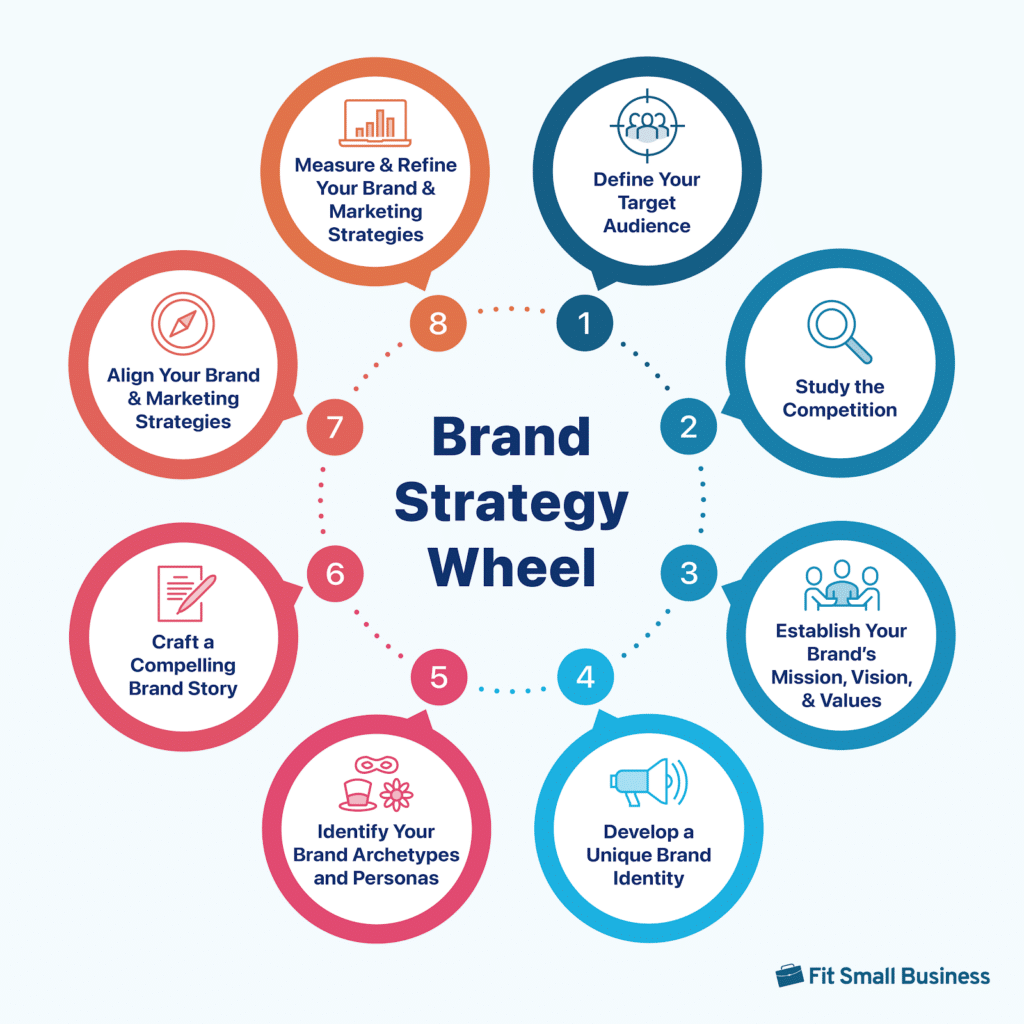
Step 1: Define Your Target Audience
To define your brand, you first need to understand your customers, both current and desired. If your business is established and already has a strong base of loyal customers, it’s important to engage with them and understand who they are and why they do business with you. What do they like about your brand? What do they dislike or feel you could improve?
There are several ways to engage with your customers and get valuable feedback.
Do you have frequent one-on-one in-store interactions with your customers? Positive in-person conversations are the best way to understand who they are and their wants and needs.
To continue the conversation, request customer names and emails in a guest book or at checkout. Make sure you explain how often you email, and make sure you offer an opt-out (as required by the CAN-SPAM Act).
Use reviews from your Google Business profile, Yelp profile, and other business directories, and the reviews left by customers as a source of insight and a way to enhance your customer service. Reach out to respondents who leave positive or negative reviews, and see how you can engage in a deeper conversation with them.
Questionnaires can be sent to customers through your email list, or cards with an in-store dropbox. Offering a discount or gift as an incentive to complete the survey is always helpful. Though anonymous feedback can be helpful, capturing names and emails gives you a way to offer something and recruit further for a more in-depth conversation such as a focus group.
Besides marketing research, many businesses also find surveys extremely helpful in assessing and improving customer satisfaction.
A focus group is a guided discussion, often with eight to 10 participants considered to be similar in demographic profile to your ideal customers. A moderator asks questions, leads the discussion, and helps ensure a safe and inviting environment for all participant opinions. Focus groups are especially helpful if you are launching a business and trying to identify who your potential customers could be.
These can be highly structured and formal, and many market research firms will organize a focus group that will do an in-depth analysis of the results and offer recommendations for you.
Step 2: Study the Competition
It’s important to understand what other businesses in your industry are doing: not just their products, services, and pricing, which is certainly crucial, but also how they present themselves in the marketplace through their brand.
One way to understand your competitors is to frequent their place of business (or send a proxy if they already know you and it feels awkward), purchase products, and gather impressions of the environment, service, and product selection and merchandising.
What is their brand? What do you think they’re doing well? Or poorly? How do you want to emulate or differentiate from them? It’s always important to be unique in some way, but exactly how unique is an important focus for competitive research.
In certain conservative industries such as healthcare, there is a fairly narrow brand differentiation while all healthcare companies tend to gravitate toward core values of trust, competency, and patient-focused care. In other industries, like apparel, having a unique look and feel from others in the fashion space is a never-ending quest.
Step 3: Establish Your Brand’s Mission, Vision & Values & Your Brand Positioning Statement
Your mission, vision, and core values define the deepest purpose of your company, your aspirations for who you want to be in the market, and the principles that define how you treat your team members, customers, and the larger community.
What are Mission, Vision, and Core Values?
- Mission: What we promise and deliver as a business right now—our core Purpose for being
- Vision: What we seek to become in our highest aspiration as a company
- Core values: In simple words, the principles we strive to embody to help us achieve our mission and vision
These three statements are important to answer for your stakeholders: What is your promise to your customers? Your employees? Your community, and the world? By engaging in this process of formulating your mission, vision, and core values, you are also starting to define your core brand values, which then carry through to your brand positioning, identity, and other aspects of brand development.
Pro Tip: The process of brainstorming and then crafting your mission, vision, and values is most effective when it involves your full team and possibly a marketing agency or consultant. Whether you work on your own or with others, the following articles on small business mission and vision statements will prove valuable:
- How to Write a Small Business Mission Statement (+Template)
- 16 Small Business Mission Statement Examples & Why They Inspire
- How to Create a Vision Statement (+ Free Template)
Brand positioning defines how your business or product stands out in the market and your unique selling proposition. Often the best brand positioning statements can translate directly into a consumer-facing tagline or slogan.
One timeless example of a tagline that clearly communicates its unique selling proposition is Nike’s famous “Just Do It.” The tagline tells customers that Nike will help them achieve incredible feats of athletic prowess if they follow this advice—and wear their shoes, of course.
Another famous example is Apple’s 90s tagline “Think Different.” Here, Apple positioned itself as the creative, individualistic choice in opposition to the more traditional Microsoft-based operating system.
To help you build your brand positioning statement, check out our article on brand positioning statement guide and template.
Step 4: Develop a Unique Brand Identity
Once you have identified your mission, vision, and core values and you have a handle on the existing and ideal customers you are trying to reach, it’s time to start distilling these discoveries into your brand identity. Brand identity consists of a number of sensory elements that are part of the presentation of your company or product(s):
- Visual components: colors, design motifs, logo, and imagery
- Verbal and auditory components: voice and tone, taglines, music, and jingles
- Other sensory aspects: touch-, taste-, and smell-based sensory inputs that evoke the feelings behind your brand
Visual Components
The primary visual component of a brand is the business name and logo. After naming, the brand identity development often begins with the creation of a logo. Logos often incorporate the company name, and sometimes use an illustration or icon that represents the company’s identity, and reinforces the customer’s recognition and experience of the brand.
This is a core aspect of building your brand identity and deserves significant thought and effort. Once you have clarified your brand values and your audience, there are many ways to develop a potent logo design for your business, including:
- Hiring a designer
- Working with a designer from a marketing agency or contractor with whom you already have a relationship
- Using a number of online sources to develop and source a logo
Working with a designer with branding expertise is typically more expensive than logo generators, but well worth it if you have a strong vision for your brand.
The color palette selected by a business should reflect both the particular mood and style of a company, but also take into account an understanding of color, psychology, and the universal associations these colors evoke.
Knowing what resonates with your core audience is also important when selecting colors. For example, a product focused on a younger audience might use more vibrant or primary colors, whereas a more sophisticated and mature brand might opt for a muted palette.
Images, photography, design motifs, and iconography are all aspects of the brand that can be incorporated into your visual presentation. You may pick photography of your place of business, customers, and products as a key part of the brand.
Stock photography can also be incorporated to represent certain business concepts or bring in imagery that is expensive to create from scratch. They can also convey the look and feel of a particular business, such as service-based businesses, without a physical retail space or products to feature. Just keep in mind, stock photos are freely available to the entire world, and if already widely used, a stock image can make your company seem generic.
Sometimes, a brand will use illustrations in addition to or in lieu of photography. Related to illustration, icons are symbols that represent a brand, product, or service and can be used to represent even a range of products and services within a brand to help give identity to these sub-brands. They are used to communicate a message and create recognition. Icons are useful in various forms, such as logos, graphics, illustrations, and more recently, emojis.
Verbal & Auditory Components
Verbal or auditory aspects of the brand start, of course, with the name of the company and/or its products. But this aspect of branding can extend much further into taglines, a motto, or the brand story expressed in written, or audio form. In audio-based media, such as radio, video, or podcasting, music and even short, musical taglines, known as jingles can be utilized to reinforce the feeling of the brand.
Furthermore, brands may utilize special sound effects, and even the volume and tone of an announcer or spokesperson to complete the auditory experience of the brand. Using these methods in the acoustic environment of a place of business is also a way to extend this aspect of brand strategy. All of these auditory strategies collectively are part of the process known as sound branding.
Other Senses Your Brand Engages
The sensory aspects of touch, taste, and smell are more specialized than visual and auditory aspects, but are core to the sensory experience of businesses such as restaurants (taste, scent) or retail (touch). For example, the lingerie retailer Victoria’s Secret is strongly associated with the feeling of the silk and lace that graces many of their catalogs and shelves of their retail locations.
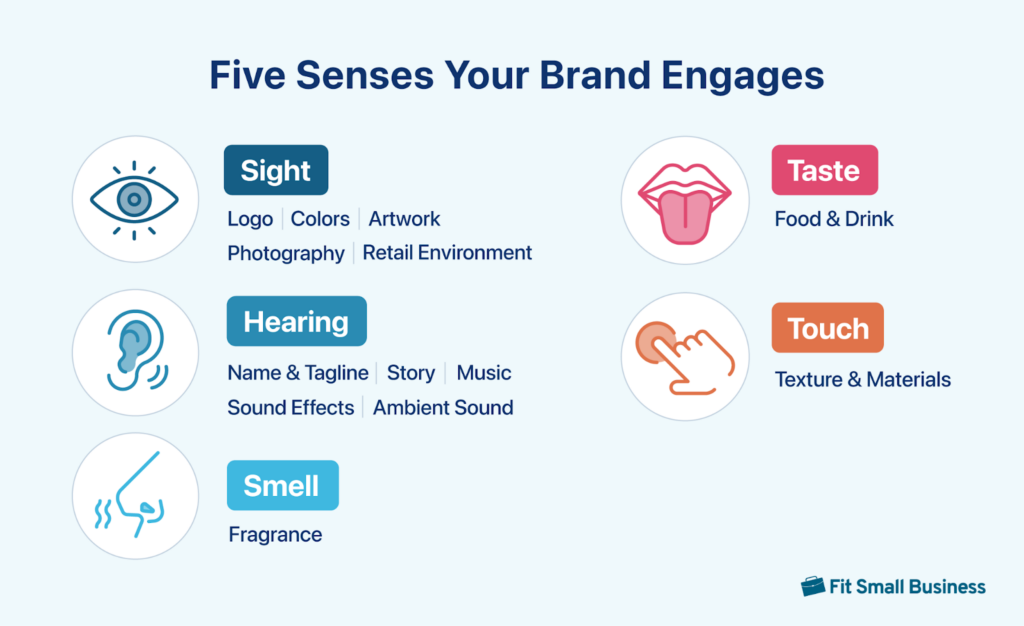
Step 5: Identify Your Brand Archetypes and Personas
Brand archetypes and personas are two slightly different but interconnected concepts that help bring a brand to life through a character or persona. When developed successfully, they are a powerful tool in brand development.
Brand Archetypes
Brand archetypes are derived from the psychological theories of Carl Jung, who used these concepts to identify core personality traits based on mythological figures. Applied to branding, archetypes can be used to identify and express the deep motivations of the core audience that you wish to associate with your brand identity, values, and story.
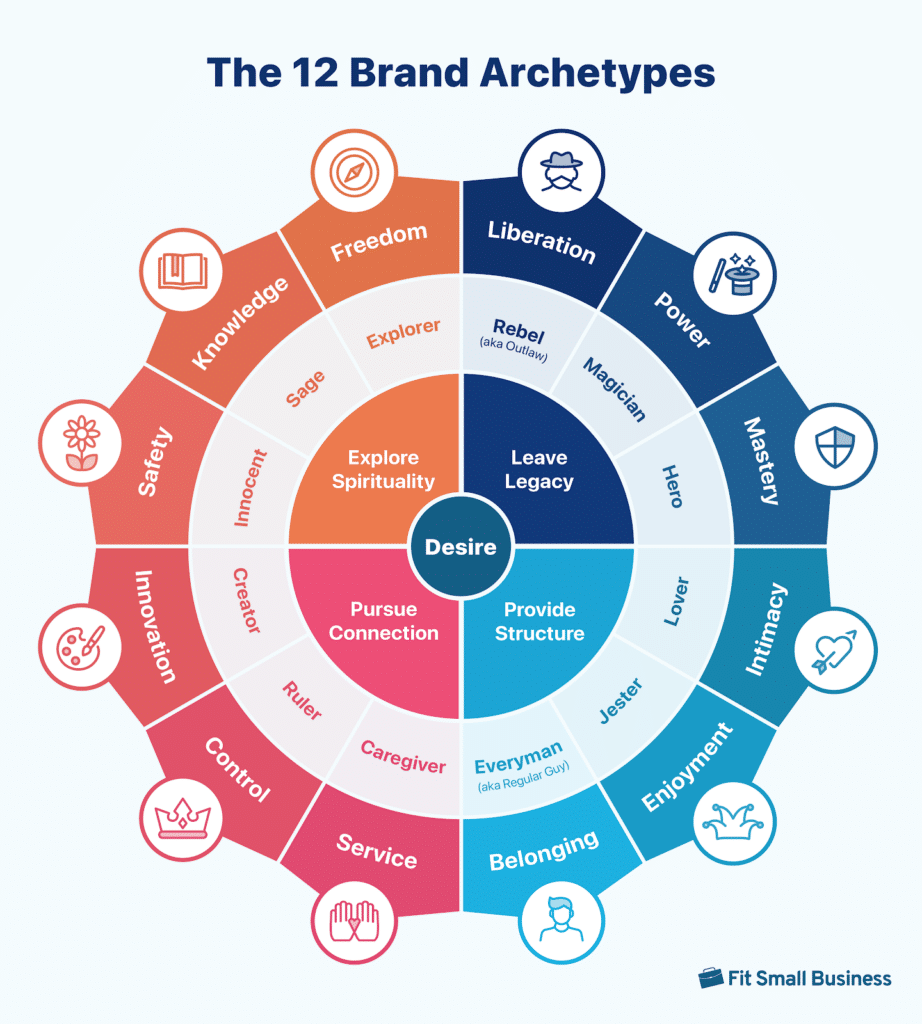
The brand archetypes are as follows:
- Lover: Embraces intimacy
- Hero: Strives for mastery
- Magician: Demonstrates power
- Rebel (aka Outlaw): Fights for liberation
- Explorer: Searches for freedom & adventure
- Sage: Seeks knowledge & understanding
- Innocent: Values safety & peace
- Creator: Pursues innovation
- Ruler: Takes control
- Caregiver: Offers service
- Everyman (aka Regular Guy): Seeks belonging
- Jester: Craves fun & enjoyment
Based on the core desire and motivation of each archetype, choose a primary, secondary, and tertiary archetype that best expresses your brand and the values you believe connect with your customers. This exercise will help you solidify your understanding of the ideal customer.
Finding the brand archetypes and personas that align most closely with your brand can clarify your brand attributes and make your identity and values more relatable to your target audience.
Brand Personas
Brand personas are characters, human or fanciful such as an animal or anthropomorphized object that embody the brand’s personality, idiosyncrasies, and tone of voice. It is often used to humanize a business and create a story that customers can connect with. Brand personas differ from customer personas, which are intended to profile the ideal customer and help you understand their deepest motivations.
The brand persona is a more down-to-earth idea than the brand archetype. Start with the mythical archetypes you chose in the previous exercise to define values, desires, and pain points that you feel most resonate with your existing or intended customers. Then, personify all of this in a character or mascot who is, in essence, your brand embodied.
Ronald McDonald is one of the most classic and fanciful examples of a brand persona, as is the more relatable animal persona Smokey the Bear, the imaginary mascot of the US Forest Service.
Like a brand logo that serves as a potent reservoir to store the wide range of feelings, associations, and meaning behind a brand in a simple word or icon, the brand persona evokes a multitude of brand traits and brings them to life.
Customer and User Personas
This is a different concept from brand personas. The customer persona is a profile of an ideal customer based on your customer research or experience. The user persona is a related concept but sometimes the user of your product or service is not the buyer, and vice-versa.
This is especially true with an expensive or complex product, especially in company B2B purchases. Determine whether a buyer or user persona is an influencer, gatekeeper, or decision maker (any or all of these) for a purchase decision, if applicable.
Step 6: Craft a Compelling Brand Story
Put simply, a brand story is the story behind the brand—the origins, values, and aspirations of your company and the compelling stories of others that exemplify your brand values.
One of my favorite films from many years ago is the movie Tucker: The Man and His Dream (1988). The eponymous hero, played by Jeff Bridges, is a visionary entrepreneur who sets out to disrupt the American auto industry and create a safer and more efficient driving experience with his own visionary car bearing his name.
Though the Tucker automobile was not ultimately successful as a mass-market product—the film is an inspiring example of a brand story. Many of the vehicle’s innovations, such as seatbelts and disk brakes, once considered radical are now considered routine in modern automotive design. Tucker’s passion for meeting his customers’ needs through fearless innovation is a quintessential American story.

Preston Tucker: Photograph courtesy of The Tucker Historical Collection and Library.
Retouched by W. Guy Finley (Source: Wikimedia Commons).
While your own brand story may not be quite as dramatic, within it you will likely find the seeds of your own passion and desire to bring a great company, product, or service into the world, and to solve your customers’ needs, or even fulfill their greatest hopes and dreams. Crafting a great story that shares your inspiration, passion, and hard work helps inspire customers and your employees, and builds trust for your brand.
Step 7: Align Your Brand & Marketing Strategies
Now, with a solid brand strategy in hand, you can begin to define the message and the media that will put your brand in front of your customers through a messaging or content strategy (“What are you saying?”) and in a channel strategy (“Where are you saying it?”). The messaging and channel strategies reinforce your brand strategy, in turn by creating content that strengthens, enhances, and becomes a part of your brand.
Medium and large companies often employ a brand manager, whose primary purpose is to help keep track of brand elements, communicate these to agencies or other creatives, and ensure compliance with brand guidelines while helping the brand expand and change as needed to adjust to the tastes of customers, and shifts in strategy. For your small business, you or your marketing staff or outside agencies may serve this function.
Once your brand is fully developed, creating a brand guide is an important step in ensuring you have a way to communicate brand elements to your staff and outside contractors responsible for communicating your brand to customers. To learn more about how to create a brand guide, and get a useful brand guide template, see our article on how to create a brand style guide.
You’ll want to ensure that the media channels and publications to place your brand message match the media consumption preferences of your target audience. Placing ads for a retirement investment fund on a cruise line company website, for example, makes sense. Putting those same ads on a skateboard fan site, probably not so much.
If you have multiple target customer personas, you may need to segment your audience (i.e., create subgroups of similar personas) and choose the various media channels for each segment accordingly. Of course, it’s helpful if these audience segments overlap on many of the same media channels, but most likely you’ll have to divide up messages and media targeting for each segment.
If budget is an issue (and isn’t it always?), striving to understand where you get the best ROI for your media investment based on the market size and share, income, and potential spend of your target audiences is critical to placing the right bets. Running an analysis of these segments to compare side-by-side will help you divvy up your budget intelligently for maximum success.
Step 8: Measure & Refine Your Brand & Marketing Strategies
How are your marketing campaigns performing? Do you think customers are resonating with your brand and your messaging? Monitor and refine brand efforts and be prepared to pivot if needed.
First make sure you feel that your brand runs consistently and clearly through all your messaging, even if it is slightly tweaked to target various audience segments or focus on different products. Track your results on your campaigns and see what insights are there. You may just need to make fine adjustments, or even pivot on your core brand assets depending on what you find out.
You may (probably) not get it all correct the first time out. Using media testing, such as A/B testing where you run two creative ads side-by-side, allows you to see what messages resonate and tell you more about your brand and what connects. Running smaller market tests initially on one or more segments allows you to experiment and learn.
It’s important to measure and analyze your media campaign metrics and to monitor and analyze these on a regular basis:
- If you run your website yourself, many website providers include some traffic analytics to track various metrics, including page views (PV), unique visitors (UV), and click-through rate (CTR).
- If you are running an online store with products, you can often track where visitors came from and see metrics such as conversion rate (CVR), average per-customer spend, and of course, sales and revenue. Many eCommerce website builders offer these capabilities.
- If you work with a marketing agency to run a campaign, the agency can track, share, and analyze the results with you.
- For social media, look at likes, reposts, and both negative as well as positive comments to gauge consumer sentiment. Social media analysis and listening tools such as Awario, Google Alerts, Social Searcher, and Hootsuite can help analyze your overall reputation across numerous social channels and the web.
Brand research and measurement methodologies consist of:
- Brand tracking: Tracks brand awareness, consideration, and preference over time
- Brand lift: Growth in consumer awareness, recall, perception, and intent from specific marketing campaign
- Brand equity: Comparison of these previously mentioned brand research methods with KPIs such as revenue, market share, and lifetime value per customer (LVC) to derive the correlation between brand and business value
Running brand measurement tools and methodologies need to run concurrently with these basic marketing KPIs. This allows you to see how your business success is tied to your brand success and assess long term brand value and brand equity.
Even if you used marketing research to develop your initial brand strategy, you may want to double back and conduct research on your customers repeatedly to ensure that the landscape hasn’t changed. Doing so gives you a chance to repeatedly test and track your brand strategy. Talk to your customers again and again as their perception and experience of your brand can change over time.
Inspiring Brand Strategy Examples
The branding strategy of Corona once centered on escaping from the stress of workaday life and relaxing on vacation. The well-known “Find Your Beach” campaign extended this imagery of “chillaxification on the playa” into everyday situations, often through imagery that juxtaposed these realities. By doing so, the campaign built upon its original brand concept of being the original “beach beer” and transposed this vibe to ordinary reality.

Image of a “Find your beach” ad campaign image that shows how you can bring the laid-back Corona vibe into even a dense urban setting (Source: Cramer Krasselt)
As the pioneer in mass-market electric vehicles, Tesla has developed an upscale brand based not only on its formidable environmental credentials, but its luxury and performance. Though Teslas are now everywhere, the image of the Tesla owner as an upstart rebel fighting against the status quo persists and is now exemplified by the edgy and divisive styling of the Cybertruck.
Imagining the brand archetypes for Tesla, the Creator (imaginative), Sage (intelligence, the smart choice), and the Outlaw (taking a different road) are the primary, secondary, and tertiary archetypes respectively.

The Tesla Model Y and the confrontational retro-futuristic Cyber Truck (Source: Tesla Motors).

The Tesla Model Y and the confrontational retro-futuristic Cyber Truck (Source: Tesla Motors).
MAC Cosmetics’ branding strategy is built around its three primary core values: a commitment to quality, innovation, and philanthropy. This high-end makeup brand strives to be the go-to for stylists and makeup artists and generates buzz and social proof for their products through marketing directly to these professionals who are also tastemakers in their industry.
Their social media presence reinforces this image by showcasing fashion-focused events that feature their products. As a premium brand, their pricing strategy reinforces this image and positions them upmarket from low-end competitors such as Revlon. Finally, their commitment to philanthropy is exemplified in their Viva Glam campaign from the 1990s, which focused on funding AIDS research.
Looking at the brand archetype concept, MAC would be most closely associated with the Magician archetype in its innovation and power to transform through beauty. Secondly, the Creator reflects its more purely creative essence, and finally, the Caregiver reflects its philanthropic aspirations and mission.
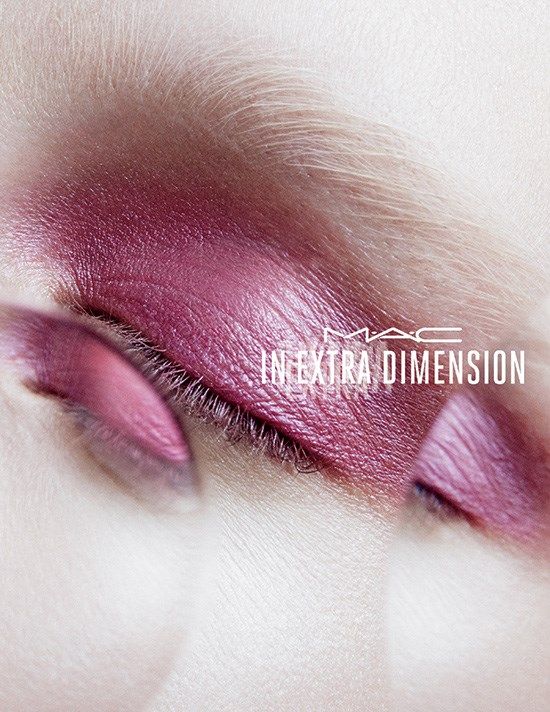
MAC Makeup’s “In Extra Dimension” ad reflects its upscale but
mysterious connection to the Magician brand archetype
How to Create a Brand Strategy Frequently Asked Questions (FAQs)
Not building your brand is actually more expensive! Depending on your goals and circumstances as a small business owner, you may feel you don’t have the time, money, or staff to build a real brand strategy as we’ve outlined here. However, making that investment upfront in creating a branding strategy will pay dividends in higher employee morale, customer engagement, and enhance the brand value of your company.
Brand strategy is the core element of your larger marketing strategy. The marketing strategy focuses on both the brand and the means by which you operationalize it in messaging and media channels. Marketing strategy also includes elements such as pricing strategy, which can indirectly affect your brand but is not a key part of it.
Hiring an outside agency or consultant might seem costly to a small business owner, but it’s a great investment if you have strong goals for profitability and growth. Marketing agencies with experience in branding can help guide you through the brand strategy process. Just getting some smart and experienced people together in a room to brainstorm is a powerful and energizing process that can’t be fully quantified but is absolutely real.
Furthermore, once you’ve developed your strategy, your agency or consultant will be more efficient and adept in further developing your marketing materials and campaigns going forward.
While many people are familiar with the big names in marketing and advertising, like McCann Erickson or Ogilvy, many smaller agencies specialize in the needs of small and local businesses, such as Lyfe Marketing, Straight North, and Hibu. But as the owner of your business, spending time first defining your brand strategy with your team will help you work more effectively with your agency to get the best results.
Bottom Line
In my own experience as a marketer focused on branding for over 25 years, I know that brand strategy is a fundamental and powerful core discipline for any business, big or small. The sooner you can create a strategy for your branding, the more powerful a tool it can be for guiding a multitude of strategic decisions for your business.
But if you haven’t done it before, don’t worry—it’s never too late to either create a brand strategy or revisit the process and touch base with where you are on your journey. The time and effort to create a brand strategy is always valuable in your quest for success.

Thank you for downloading!
The Fit Small Business Brand Strategy Template. You can use this template to develop a comprehensive brand strategy for your business.
Quick Tip:
Need professional help developing your Brand Strategy?
Reach out to Straight North for expert branding help tailored to the small business owner.
For more informative articles from Fit Small Business, Please visit our website at https://fitsmallbusiness.com/marketing/.





